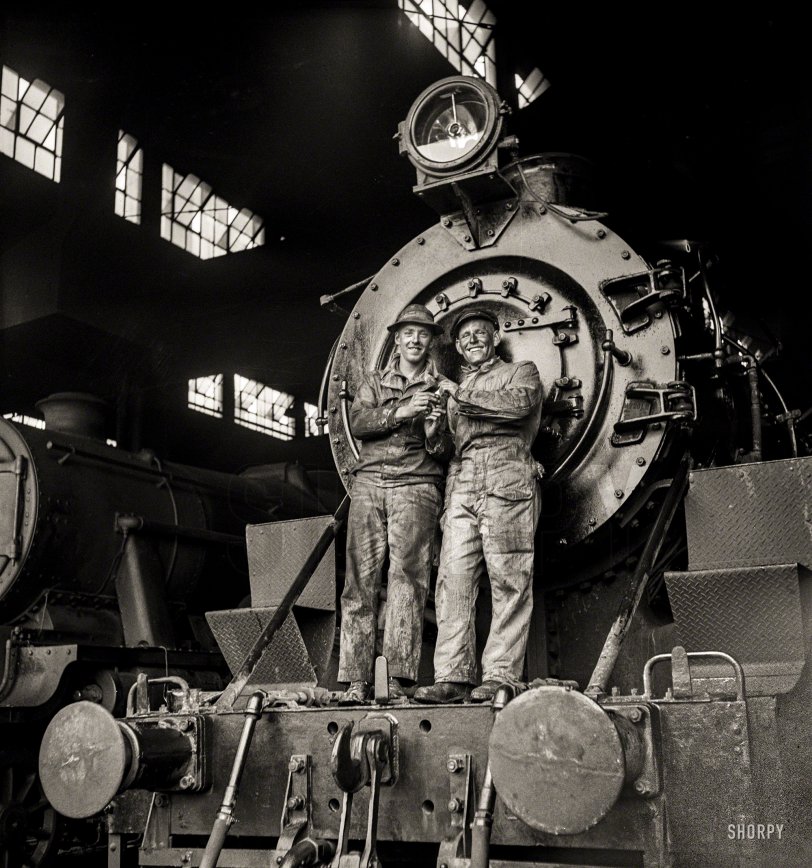


Framed or unframed, desk size to sofa size, printed by us in Arizona and Alabama since 2007. Explore now.
Shorpy is funded by you. Patreon contributors get an ad-free experience.
Learn more.

- Texas Flyer wanted
- Just a Year Too Soon
- WWII -- Replacing men with women at the railroad crossing.
- Yes, Icing
- You kids drive me nuts!
- NOT An Easy Job
- I wonder
- Just add window boxes
- Icing Platform?
- Indiana Harbor Belt abides
- Freezing haze
- Corrections (for those who care)
- C&NW at Nelson
- Fallen Flags
- A dangerous job made worse
- Water Stop
- Passenger trains have right of way over freights?
- Coal
- Never ceases to amaze me.
- Still chuggin' (in model form)
- Great shot
- Westerly Breeze
- For the men, a trapeze
- Tickled
- Sense of loneliness ...
- 2 cents
- Charm City
- What an Outrage
- Brighton Park
- Catenary Supports
Print Emporium
Somewhere in Iran: 1943

March 1943. "American and British engineers taking time out for a smoke. They are standing on an American locomotive somewhere in Iran." Medium-format negative by Nick Parrino for the Office of War Information. View full size.
Baldwin-built S200
The loco is one of 70 S200 2-8-2s built by the Baldwin Locomotive Works. The curved footplate/steps from the pilot deck and the Okadee smokebox hinges are what distinguish it from an S160, which had their air compressor mounted on the smokebox front. I regularly fire on a post-WW2 BLW engine derived from the S200 design.
One other British feature not mentioned is the J. Stone and Co. "Tonum" headlight. I'd guess this was fitted in Iran, as the majority of their locos, stock and equipment were made in the UK.
Model 1941 Utility Uniform
The man on the left is definitely the American, indicated by his Model 1941 utility uniform. Made of OD green herringbone twill cotton, it was the standard fatigue and hot-weather combat uniform for the US Army during the first half of WW2.
USATC S160 Class.
The locomotive is a standard type called a S160 class. These were a 2-8-0 (4 driving axles) locomotives built by numerous builders to a simplified standard design. So looking at the builder's plate isn't going to tell you much, since the engines were identical in every way other than the plate.
Stanier 8F
Definitely a Stanier 8F 2-8-0 on the left. Wikipedia says that 163 were sent to Iran, of which 143 actually arrived, 12 were lost to enemy action and 8 were returned to Britain after being damaged on the journey.
The British style buffers, coupling and lamp irons are clear enough. What's also clear is that the British engineer is the one with the big grin on the right. I think the pork pie hat and bum-freezer jacket give the American away.
Stage Left
The loco barely in shot to the left looks like a British-built 8F. Many of these were exported to the Middle East during WWII. Zooming in shows the vacuum ejector exhaust going into the smoke box
The welded bit on the draw hook arrangement is a cover/protective plate. The draw hook itself goes through the buffer beam and has (usually) a rubber sandwich springing arrangement at the back.
Locomotive designs
There were many locomotives made in the US for use overseas, and as such, were equipped to match requirements in the destination country. In this case, I would strongly suspect that the buffers and draft gear were installed at the US factory. The four holes around the hook may have been provided to allow installation of a Buckeye or Janney (North American) coupler should that be needed - or, for that matter, some other form of coupling.
The three upright metal "fingers" are for "head lamps" (not to be confused with North American headlights - see the headlight in front of the chimney). Lamps were placed on those fingers in various patterns to indicate the class of train. In England, for example, two lamps, one over each buffer, indicated an express passenger train. English use included another "finger" (lamp iron) near the top of the smokebox - but perhaps not here, because the headlight would obscure the smaller lamp.
Quick Change
While the British style hook and link is welded on, it is surrounded by 4 holes for mounting the holder for a North American coupler. The 3 upright metal "fingers" may also be for the uncoupling levers of the alternate devise. The buffers are bolted on and easily removable.
Mixed motives
The smokebox door plainly says North America, but the buffers and draft gear are definitely British. and BTW the British engineer is likely the fellow on the right, as evidenced by the large rectangular pocket on his left thigh.
[Could the locomotives have been modified to make them compatible with British equipment in use there? -tterrace]
Supply route for the Soviet Union
Britain and the Soviet Union invaded Iran in 1941 to insure a safe supply route to the Soviet Union and to make sure the Iranian oil fields were in safe hands. Reza Shah, who was believed to be a German sympathizer, was deposed and his young son Reza Pahlavi was placed on the throne. This is the reason why there is an American locomotive in Iran to move supplies north.

























On Shorpy:
Today’s Top 5